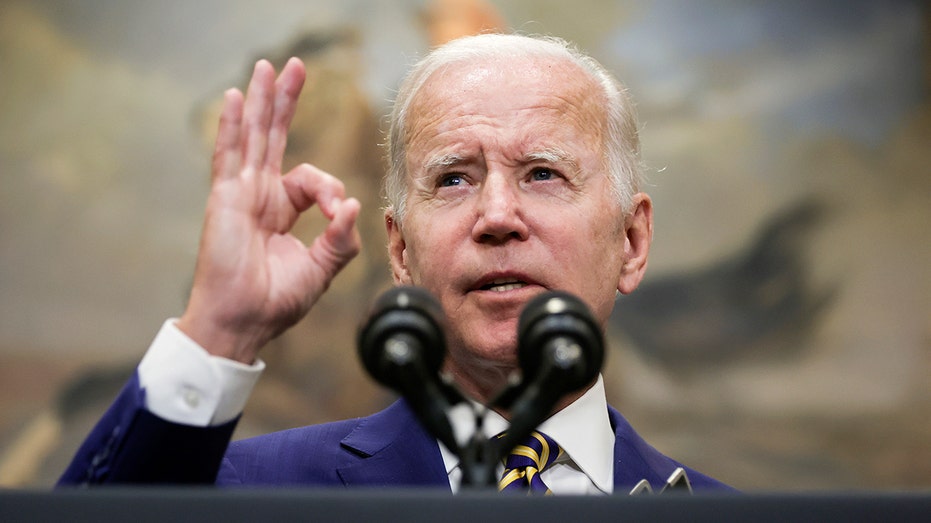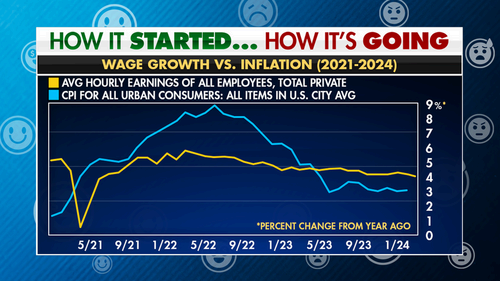Michael Lee Strategy founder Michael Lee and CFRA senior equity analyst and Vice President Garrett Nelson weigh the UAW strike’s impact on the stock market.
Wage growth in the United States has lagged behind inflation for most of President Biden’s term in office, with average hourly pay today below what it was in January 2021.
However, in the last year and overall since the pandemic, wage growth has outpaced inflation, a fact the White House has celebrated as Biden seeks re-election to a second term in November.
“Inflation is down two-thirds from its peak and annual core inflation is the lowest since May 2021. Wages are rising faster than prices over the last year and since the pandemic,” Biden said last month when the Labor Department released its Consumer Price Index (CPI) report for February.
“Prices for key household purchases like gas, milk, eggs and appliances are lower than a year ago. Inflation is down while unemployment has remained below 4% for the longest stretch in more than 50 years,” the president said.
US ECONOMY ADDS 303K JOBS IN MARCH, MUCH STRONGER THAN EXPECTED

President Biden speaks at the White House on Aug. 24, 2022. (Alex Wong / Getty Images)
Wages rose 4.1% year over year in March while employers added 303,000 jobs, beating economists’ expectations. The unemployment rate dropped to 3.8% from 3.9% in February, according to the Labor Department. Those strong numbers have continued a trend of robust jobs and wage growth, even if the average hourly pay for Americans has not kept up with the growth in consumer prices.
The country’s inflation-adjusted, or “real” average hourly wage, as of February 2024 is $11.11 per hour, a decrease of 29 cents from $11.40 in Jan. 2021, or minus 2.54%.
The first three months of Biden’s term saw wages grow faster than inflation. But beginning in April 2021, American workers experienced 25 consecutive months of negative real wage growth, averaging -2.0%.
“Between April 2021 and April 2023, prices grew faster than inflation and workers saw their earnings fall about 4% in real terms. But since May 2023, wages have been growing faster than prices again,” said Julia Pollak, chief economist for ZipRecruiter.
MARCH INFLATION REPORT: ANOTHER MONTH OF ‘HOT’ PRICE GAINS EXPECTED

This line graph shows the annual percent change in average hourly earnings of all employees compared to the annual percent change in the consumer price index for all urban consumers from 2021 to 2024. (Fox News / Fox News)
While inflation today has fallen from a peak of 9.1%, when compared with January 2021 — shortly before prices began to spike — the consumer price index is up a stunning 18.49%. Average hourly earnings of all employees have increased 15.9% over the same period.
Inflation creates severe financial pressures for most U.S. households, especially low-income Americans, who effectively take pay cuts when prices rise. Before the pandemic, workers were used to wages growing at a faster rate than inflation.
“Workers grew accustomed to getting a wage boost each year to keep pace with inflation, plus another boost to capture productivity growth. Wage growth also rose as the unemployment rate fell, the labor market got tighter, and employers had to work harder to recruit and retain workers. So, wage growth was about 1.5% higher than inflation in 2019,” Pollak said.
In the last two months, real wage growth has been 1.2% and 1.1%, hovering around the pre-pandemic average. But Pollak noted that not all workers see wage gains at the same pace.
HOW IT STARTED … HOW IT’S GOING: HOMES HAVE BECOME LESS AFFORDABLE SINCE BIDEN TOOK OFFICE
“Employees in information, manufacturing, construction and retail have now seen their wages grow more slowly than inflation and fall in real terms since the pandemic. Meanwhile, employees in leisure and hospitality have seen their wages go up 28.9% since the pandemic, or 8.9% in real terms — about twice as fast as would have been expected before the pandemic,” she said.
“Overall, the lowest earners have seen their wages grow more quickly than those in the middle and at the top, so the wage gap has narrowed since the pandemic, even as the wealth gap widened, due to the enormous gains in housing and stock market wealth experienced by wealthier households.”
Looking ahead, Pollak said real wage growth is rising for three main reasons: Inflation is slowing more quickly than wage growth; productivity growth is high; and low unemployment rates are continuing to drive wages higher, so firms can recruit competitively.
“There are still risks. [For example], the recent surge in oil prices could raise inflation and erode some of the progress workers have made recently,” Pollak said. “But for the most part, wage growth appears for now to be headed in the right direction thanks to normalizing inflation and tight labor markets.”
GET FOX BUSINESS ON THE GO BY CLICKING HERE
While jobs and wages grow, Biden has called on Congress to do more to lower costs for Americans, especially the middle class. In his State of the Union address last month, the president put forward plans to lower prescription drug costs, build 2 million new homes to lower rents, and cut taxes for Americans making less than $400,000 while raising taxes on businesses and the wealthy.
Former President Trump, the presumptive GOP nominee for president, has called for additional tax cuts to stimulate economic growth and higher tariffs on imported goods to protect American jobs and boost manufacturing.



